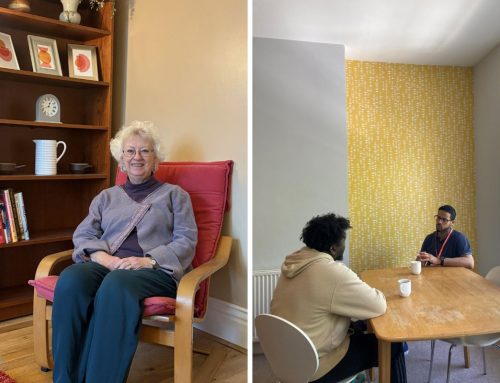Action Language classes came to an abrupt halt in March as the UK went into lockdown and the Covid-19 pandemic turned everyone’s lives upside down. Since then the team have been working incredibly hard to find a way of making sure asylum seekers, refugees and other migrants in Tyne & Wear can access free English lessons from home.
It’s not a one size fits all situation, as not all of our learners have the same access to technology – with some people using computers, others trying to get by with a mobile phone with limited phone credit and then there are those who literally have none of that at all.
So, we’re assessing everyone’s needs individually and will be delivering free English language lessons in a few different ways including:
- 30 minute live video lessons with volunteer teachers via Zoom
- Lessons posted on a website that can be easily accessed on any device
- Printed worksheets sent out directly to learners
Action Language volunteer Hilary Bennison is one of the teachers who will be leading the Zoom lessons and has kindly agreed with her fellow volunteer Michael to write a diary of how everyone gets on with this new approach to teaching. Here’s the first instalment…
So now it’s official. After a couple of weeks of rumours, exploratory emails and preliminary zoom meetings, Action Language has decided to start online teaching using zoom, and Michael and I’ve been signed up to do a 30-minute lesson each for Entry 2 students once per week. We’re not expecting large numbers, at least not to begin with, but hopefully once word spreads of our scintillating sessions, students will come flocking!
Ready or not, here we zoom!
Like a large proportion of the population, before the lockdown started, I thought zoom was a verb used to describe the noise made by young men with fast cars and high-octane lifestyles. Within a couple of weeks however, I found myself zooming regularly with family and friends, singing with my choir, having a knit and natter with my granddaughter, joining quiz nights, book groups and even sharing meal-times on zoom.
At first, this was revelatory and enjoyable and definitely helped to overcome feelings of distance and isolation. As time wore on, however, I began to realise the downsides; the time lapse, the interruptions, the fact that there is always someone who dominates, and the need for a good Chairperson even (or especially) among large family gatherings. So gradually I have reverted to the tried and tested phone call for meaningful conversations with loved ones, and have tried to keep zoom meetings to a minimum.
How hard can it be?
But here I am about to embark on teaching using zoom! The main difficulties are obviously going to be technology-related, but that’s not a problem. As anyone who knows me will attest, technology is a real strength of mine. After all, I only had to attend Ruth’s session on using a whiteboard three times before I got the hang of it, so using zoom can’t be that difficult, can it?
Next time, Michael will report back on his first lesson and what we learnt from the experience.
English Classes
Do you need English practice at home? Text ENGLISH to 07520 619 511 or WhatsApp ENGLISH to 07518 460 198






